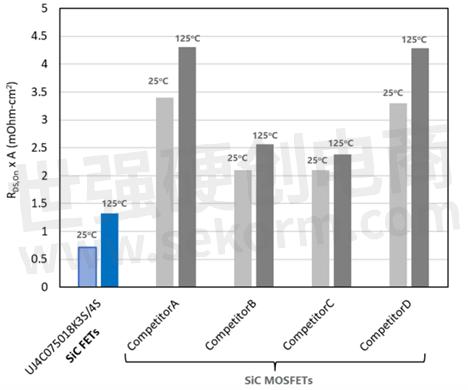UnitedSiC‘s Gen 4 SiC FET Boasts An On-resistance per Unit Area 2~3 Times Better than for The Other SiC MOSFETs

Through a combination of different attributes, Silicon Carbide (SiC) has established itself as the premier semiconductor technology for the electric vehicle (EV) sector – with devices outperforming those based on conventional Silicon (Si). Its advantages include elevated voltage ratings, superior power conversion efficiency levels, and the ability to deal with heightened temperatures.
On-board chargers (OBCs), DC-DC converters, and traction inverters all benefit from SiC, with the ongoing process and architectural enhancements certain to increase its already considerable appeal. Such enhancements will extend the reach of this wide bandgap material's operational parameters and further mitigate the power losses experienced. At the same time, the economies of scale that larger production volumes allow will mean that it can hit more attractive price points.
Use of SiC in an EV context
Covered very briefly, here are some of the dynamics now influencing the EV sector. Each should be given due consideration.
1. The need for more rapid charge cycles – Because of this, EV engineering teams are looking to deploy OBCs that can work at higher voltages. SiC devices have been introduced that can accommodate these voltages. The 650V voltage-rated devices that are generally available are not always sufficient, and higher voltage rating semiconductors are needed to accommodate higher battery voltages. At the same time, the cost premiums relating to the use of devices with 900V or 1200V ratings will be hard to justify. Solutions that offer a certain degree of voltage elevation, but without pushing up the expense involved too greatly would be the best fit here.
2. The need to support higher operating frequencies – To switch faster, switching losses must be minimized. Otherwise, efficiency levels will be reduced, and more space will be needed for thermal management mechanisms (which will add to the overall size, weight, and cost, and is, therefore, something that needs to be avoided).
3. Bringing about a significant reduction in the operating losses – By doing this, the range that can be covered by an EV before recharging is necessary will be extended. It is equally valid to use this for the downsizing of EV batteries. Both are interesting prospects for vehicle manufacturers.
4. Cost considerations – Another important factor that will accelerate the migration from internal combustion engine vehicles to EVs is the ability of manufacturers to reduce the investment that consumers must make when purchasing these vehicles. If this is to be done, then the costs relating to the various component parts must be curbed (the inverter element being a particularly large proportion of the overall expense).
Recognizing the nature of these dynamics, and the urgency with which a viable solution needed to be found proved pivotal in driving UnitedSiC to develop its fourth generation (Gen 4) SiC technology. The specification improvements that have been made over the SiC technologies offered by other vendors are illustrated in Table 1. Here the new 750V-rated UJ4C075018K4S SiC FET is compared with three alternative 650V SiC MOSFETs, plus a Si-based super-junction FET device. Even though the Gen 4 SiC FET has a markedly higher voltage rating, the on-resistance per unit area of this technology is two to three times better than for the other SiC MOSFETs and more than an order of magnitude better than the Si FET option. This means that comparable performance can be achieved in much smaller format packages.

Table 1: UnitedSiC Gen 4 SiC FETs versus Si Superjunction and SiC competitive devices
The reason for the ultra-low on-resistance per unit area is the high-density trench SiC JFET structure incorporated into the SiC FET. This is co-packaged with a low voltage Si MOSFET. The reduced area of the SiC JFET means that an extraordinarily low on-resistance will be exhibited for a given chip size (Figure 1). Conversely, a smaller FET with lower capacitance could be utilized while keeping down at an acceptable on-resistance.

Figure 1: On-resistance per unit area comparison between 750V-rated UnitedSiC Gen 4 SiC FETs and rival 650V-rated FETs
To reduce the electrical and thermal resistance values (and keep the associated losses in check) the SiC substrate has been thinned considerably. To maintain structural integrity, the thinned substrate is attached to a Copper (Cu) lead-frame via a silver (Ag) sintering material (which has six times better thermal conductivity than standard soldering materials).
Other advantages that are derived by UnitedSiC's Gen 4 SiC technology include a dramatic lowering of the associated gate driving losses. This means that switching speeds can be as much as trebled without any risk of the gate drive ICs becoming overheated. There I no need for a negative gate drive. Thanks to the low forward voltage drop (VFSD) and minimal reverse recovery charge (QRR), a superior VF.QRR figure of merit (FoM) is exhibited. This cannot be matched by what any device currently on the market can deliver.
SiC is already making EV drivetrains and battery systems more efficient, allowing performance benchmarks to be attained that are way beyond the confines of Si semiconductor technology. The advent of next-generation SiC technology will further affirm its value in relation to the wider proliferation of EVs across the globe over the coming years.
- +1 Like
- Add to Favorites
Recommend
This document is provided by Sekorm Platform for VIP exclusive service. The copyright is owned by Sekorm. Without authorization, any medias, websites or individual are not allowed to reprint. When authorizing the reprint, the link of www.sekorm.com must be indicated.
























































































































































































































































































































































































































































































































































































































































































































































































































































































































